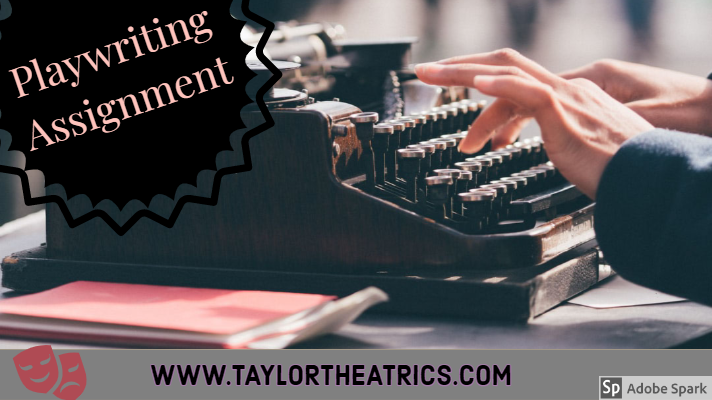My Theatre classes each have three performances, one in the fall and two in the spring. For our first performance, students participate in a play pass which allows them to look at several one act plays within a single class period and decide on one to pitch to the class to perform. Starting with a published play helps students become familiar with the play format. For our second class performance, my students fulfill a playwriting assignment for which they write 10-15 minute one act plays, one of which we will produce. For our final performance, we adapt a student play into a short film.
The playwriting assignment gives students experience and insight into the playwriting process. It also allows them to see why we don’t make changes without first consulting the publisher and/or playwright. Fortunately, this process does allows our class more freedom to request edits to the play as needed to suit our needs since we are able to work directly with our playwright as we produce our play.
Prior to explaining the assignment, I post directions, a formatting guide, and a rubric on Google Classroom to reference. See below the directions that I post on Google Classroom for the students:
 Playwriting Assignment:
Playwriting Assignment:
- For the next three weeks, we will each write a 10-15 page/minute play, due Mon. Nov. 18. However, if you plan to enter the Young Playwright Competition, it must be completed by Fri. Nov. 15. I’ve attached a formatting guide which outlines the style you should incorporate.
- You must include an historical element (a person, place, thing, or event that is historically significant). in your play. It does not have to be the focus of the play unless you want it to be. It can be a minor element.
- Before submitting your play, you need 2 editors who will leave notes (minimum of two comments EACH) by making comments on your script in Google Docs (Share your play with them in order for them to edit/make comments).
- Then, revise your play by making corrections based on the comments made for a grade (100 points possible).
- Finally, submit your completed play by attaching it and clicking submit/turn in.
- Write your play based on the number of students we have in class, assuming that one person will run lights and another will run sound. Everyone else would be a character.
- Play pitching will begin Nov. 25. as a separate grade. If you wish, we will add your play to the ballot to vote on whose play we will perform after everyone has pitched.
We use Google Docs for writing plays because it is free and has sharing options. Microsoft Word would work just as well, though. Also, I explain the importance of the historical element because it adds depth and could be used to help promote their play and make it more relevant.
 Playwright Website
Playwright Website
Once the plays are submitted, I require students to create a website which they will use to pitch their play. We take three to five days to create the website using Google Sites. (Check back later for an article on how to have students create a no cost website as a playwright promoting their plays).
Play Pitch
Pitches must include the title, a brief summary, an explanation of characters (number of male/female roles and how it is suitable for our class), the time/length of the play, and why it would be a good play for our class to perform. Their pitch must also sound believable (They should sound excited about their play.). If they truly don’t want their play performed, they are able to tell me after their pitch, and it will not appear on the voting ballot.
Voting
After students have had the opportunity to pitch their play, the class votes on which play to produce. To make voting fair, each student has two votes but may not vote on any play more than once. This eliminates students only voting for their own play. You could print ballots, but I usually just type up the students names and play titles, pull them up on my smart board, and allow the students to each write down on a slip of scrap paper the names of the two plays that they are interested in performing.I take the three plays receiving the most votes and decide which would be best for the class to present either based on content and/or the cooperativeness of the student playwright. I ultimately tell the students that as producer, I have the final say in all productions. This helps students realize that although they wrote the play, as a student they have boundaries. Ultimately, it’s a wonderful, collaborative assignment that both the students and I look forward to every year. My students look forward to the playwriting assignment more than any other type of writing assignment.
Short Film
For the plays that are not chosen to be produced as a one act, we later 
In Conclusion
Students truly love the playwriting assignment, and it gives them a newfound respect for playwrights and the process that they endure to make a great play. The assignment works well for English teachers transitioning into a theatre classroom, although having an English degree certainly isn’t necessary. As an added benefit, the playwriting assignment can provide some quit time.
You might also like my article
Play Plass: Performance Selection for Students.
My Top Script Sources









I didn’t realize that it took a while to do all of this. This sounds like fair voting! Also, it’s cool how you create a film about it? Do you guys have them on youtube to watch or something?
No, although I help the students produce them, the films are ultimately the property of the students who create them. If they choose to upload them on their own, they can, but I don’t personally upload them myself.